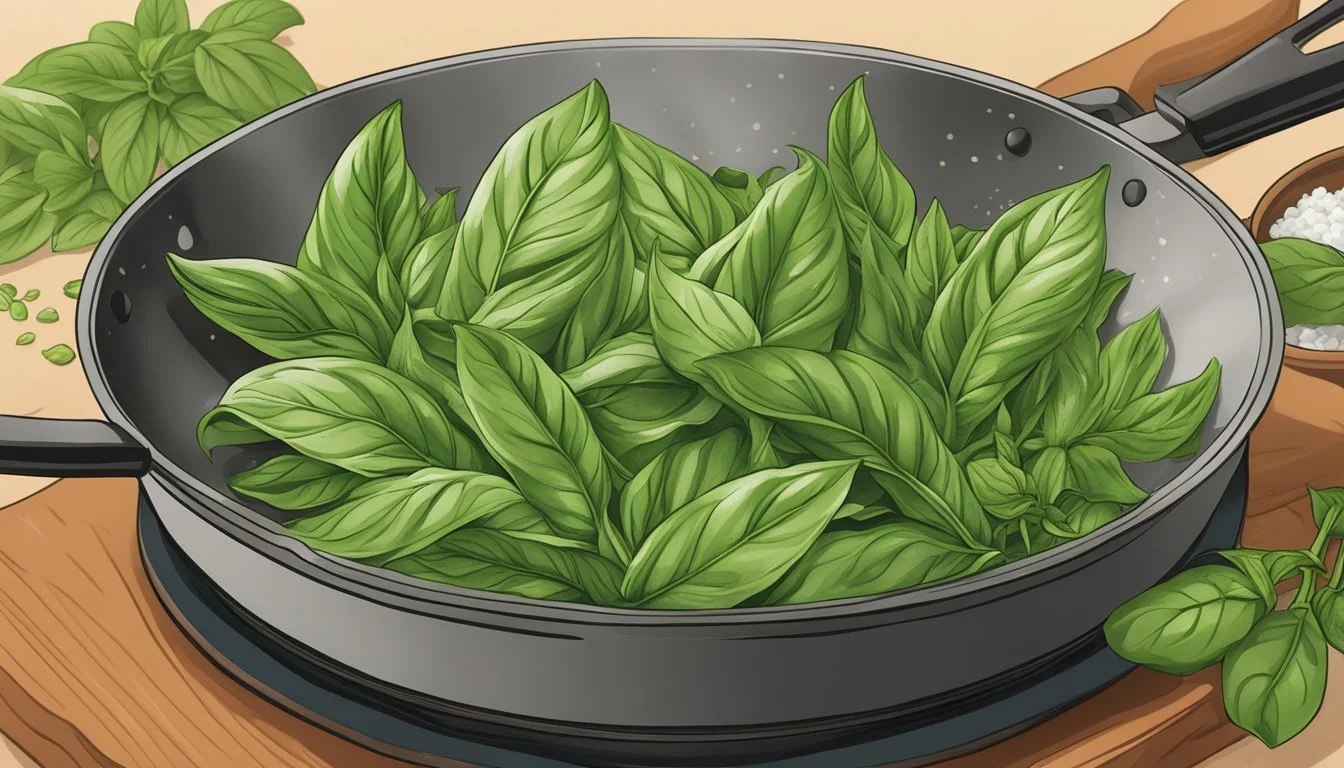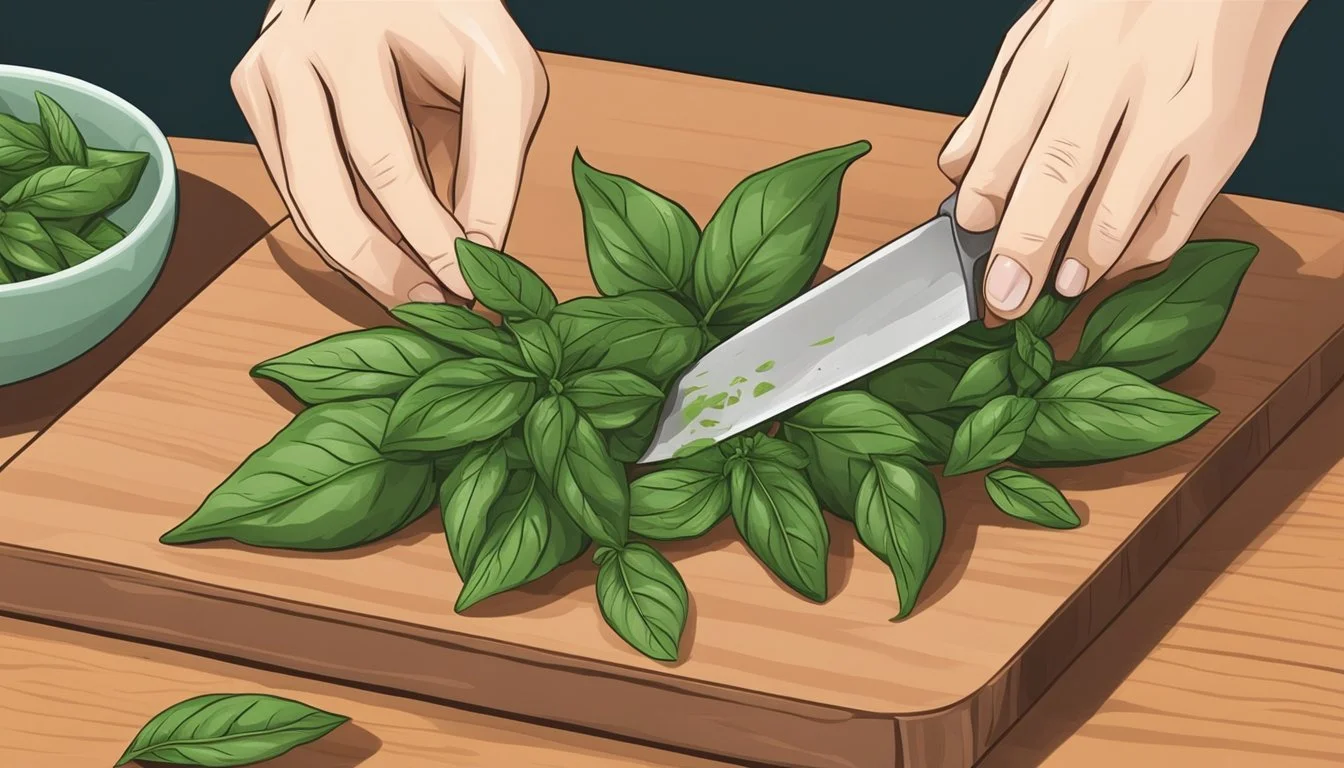How to Substitute Thai Basil for Sweet Basil
An Easy Guide
Thai basil (how long does basil last?), a staple in Southeast Asian cuisine, is known for its distinctive anise-like flavor and robustness in cooking, often retaining its character even after exposure to high heat. While sweet basil is more commonly found in Western dishes, providing a milder taste with subtle hints of pepper, mint, and clove, there are occasions where a cook might need to substitute Thai basil for sweet basil. Understanding the nuanced differences between these two varieties of basil is crucial for achieving the intended flavor profile in various dishes.
Substituting Thai basil for sweet basil can be a simple process, but it requires an awareness of the flavor complexities that each brings to a dish. Thai basil imparts a stronger licorice or anise flavor alongside a slight spiciness that is absent in sweet basil. In recipes where sweet basil is the herb of choice, introducing Thai basil as a substitute must be done thoughtfully to ensure that this bolder taste complements the other ingredients without overwhelming them.
Culinary experts suggest a few guidelines for making this substitution a success. They recommend starting with a smaller amount of Thai basil than the recipe calls for sweet basil, as its pungency can easily dominate. Cooks may adjust the quantity as they taste, aiming to strike the right balance that honors the dish's original essence while introducing the complexities of Thai basil. This flexible approach allows for precision and personalization, adapting to the varying palates and preferences of each individual or culinary tradition.
Understanding Basil Varieties
Basil varieties are numerous, each with a distinct flavor profile and culinary use that sets it apart. Thai basil and sweet basil are two popular cultivars, each integral to their respective cuisines.
Thai basil (Ocimum basilicum var. thyrsiflora), often seen in Southeast Asian cuisine, imparts a robust licorice or anise-like flavor. It distinguishes itself with sturdy leaves, a purple stem, and a spicier edge, making it a staple in dishes like curries, pho, and other Thai favorites.
Conversely, sweet basil, often referred to as Italian basil or Genovese basil (Ocimum basilicum), is milder and more prevalent in Mediterranean dishes. Sweet basil’s subtle pepperiness with hints of clove complements the flavors of pesto and other Italian sauces without overwhelming them.
Variant Flavor Notes Cuisine Association Stem Color Aromatic Profile Thai Basil Licorice, Anise Southeast Asian Purple Strong, spicy Sweet Basil Pepperiness, Clove Italian/Mediterranean Green Mild, sweet
Lesser-known types such as holy basil (Ocimum tenuiflorum) have a peppery and clove aroma, while lemon basil presents a citrusy fragrance. These can substitute Thai basil when necessary, with considerations for their unique flavor notes.
Basil’s versatility is attributed to its varied aroma and taste, influenced by the plant's essential oils. Sweet basil’s clove scent comes from eugenol, while Thai basil’s licorice aroma is due to anethole. These essential oils contribute to their characteristic flavors and are critical to achieving authenticity in regional dishes. Each basil variety supports the essence of its cuisine, whether adding depth to Thai curries or freshness to Italian pesto.
The Role of Basil in Cooking
Basil, revered for its aromatic qualities, holds a prestigious place in global cuisines, with its sweet and peppery flavor enhancing the taste of a multitude of dishes. This herb forms the backbone of various sauces, both in fresh and dried forms. In Italian cuisine, it is essential to the character of pestos and is a distinctive component of many Mediterranean dishes.
In Southeast Asia, particularly in Thailand, Vietnam, and India, basil elevates the complexity of flavors in curries, noodle dishes, and stir-fries. Sweet basil is prominently used to infuse a subtle sweetness into soups and sauces. As each variety of basil has its distinct flavor profile, it also dictates the type of recipes it complements:
Italian Basil: Predominant in Mediterranean recipes.
Thai Basil: Offers a robust presence in Southeast Asian cooking.
Uses in Various Dishes:
Sauces: Basil's versatility shines in tomato-based and creamy sauces (What wine goes well with creamy sauces?).
Curries: It adds depth alongside other spices.
Salads: Fresh leaves contribute bursts of flavor.
Soups: It serves as a nuanced undertone or garnish.
Pasta Dishes: Basil's sweetness complements acidic tomatoes.
Stir-fries: The herb stands up to high heat and melds flavors.
Garnish: Chopped or whole leaves enhance visual appeal and taste.
Basil's role is not merely as a seasoning but as a foundational element that brings a dish to life. It is as important for its flavor as for its aromatic contribution to the cooking experience. Chefs rely on the herb to round out flavors and create a more palate-pleasing experience, whether providing a fresh top note or a subtle undertone.
Substituting Basil Varieties
When substituting Thai basil for sweet basil, one must consider the unique flavor profile each provides. Thai basil stands out with its spiciness, peppery flavor, and distinct licorice notes. Although sweet basil is more common in Western cuisines with a milder profile, it can mimic Thai basil's characteristics when combined with other herbs.
Substitutes for Thai Basil:
Lemon Basil: It is aromatic and citrusy, bringing a brightness that resembles Thai basil's lemony edge.
Holy Basil: This herb offers a robust clove-like and peppery flavor, akin to Thai basil, but with stronger spiciness.
Cinnamon Basil: Exhibiting a warm, spicy undertone, cinnamon basil contains hints of cinnamon, which can partially emulate Thai basil’s aroma.
Substituting requires careful consideration of the aromatic qualities of herbs. For example, when sweet basil lacks the anise-like undertone of Thai basil:
Herb Flavors Notes Tarragon Licorice, Sweet A hint complements sweet basil to replicate Thai basil notes. Star Anise Licorice-like, Strong Use sparingly to introduce a robust licorice accent.
Other herbs such as oregano, parsley, or cilantro deviate from the licorice notes but still offer a fresh and pungent uplift to dishes. Mint can contribute a cool, crisp accent to the mix, balancing the lack of spiciness in sweet basil.
While substituting, it is essential to experiment with proportions to achieve a desired flavor balance. None of these herbs alone will perfectly replace Thai basil, but thoughtful combinations can bring your dish closer to the authentic flavor of Thai cuisine.
Flavor Comparisons and Considerations
When substituting sweet basil for Thai basil, one must consider the flavor profile differences between the two herbs. Thai basil is known for its robust presence, marked by a unique flavor profile that includes anise and licorice notes. It imparts a peppery and slightly spicy kick, which is often associated with its pungent scent.
In contrast, sweet basil, typically used in Italian cuisine, provides a milder aroma with sweet and savory undertones. While it lacks the distinct anise flavor, it carries hints of mint and sage, lending a fresh characteristic to dishes.
When substituting sweet basil for Thai basil, consider the following:
Aspect Thai Basil Sweet Basil Scent Strong, pungent Milder, sweeter Taste Peppery, anise-like Sweet, less intense Effect on Dish Adds spicy, herbal notes Imparts a subtle, sweet aroma
Sweet basil can be a substitute in recipes calling for Thai basil, but the cook should be aware that it will alter the intended flavor profile. Sweet basil may introduce a gentler, less complex flavor. For a closer match, adding other elements like ground anise or star anise may help mimic the licorice tones of Thai basil.
Additionally, the substitution ratio is typically one-to-one, but adjustments can be made based on personal taste and the desired intensity of flavor in the dish. It is essential to recognize that sweet basil may become bitter if overcooked, whereas Thai basil maintains its flavor integrity even after prolonged cooking, which can be beneficial in slow-cooked dishes.
In summary, while both herbs contribute a green freshness, the scent and aroma of Thai basil is more pronounced, which should guide the quantity used when substituting to achieve a similarly earthy, sour, or savory result.
Adapting Recipes for Basil Substitution
Substituting Thai basil with Italian sweet basil, commonly known just as Italian basil, can alter the flavor of Southeast Asian dishes while maintaining a fresh, herbal character. While authentic Thai dishes such as green curry, pad Thai, and Thai salads usually call for Thai basil's unique spicy and anise-like flavor, Italian basil can still be used with good results.
For Thai Curries and Soups: Italian basil can be added toward the end of cooking to avoid flavor loss and maintain its vibrant color. In green curry, pad Thai, and even Vietnamese pho, start with a slightly smaller quantity of Italian basil and adjust according to taste, as its flavor is less intense.
For Noodle Dishes and Stir-Fries: Italian basil should be added just as you would with Thai basil—stirred in at the last minute. The sweetness of Italian basil complements ingredients like fried rice and noodles without overshadowing them.
For Italian Cuisine: When using Italian basil as a substitute in Thai dishes, one can lose some of the dish's authenticity. Yet, it blends seamlessly into Italian recipes, such as pesto, pizza, tomato sauces, and Caprese salads (What wine goes well with caprese salad?). It's also used to enhance the flavor of cocktails, veggies, and more.
Here’s a simple table to guide substitution:
Thai Dish Substitute with Italian Basil Note Green Curry Start with 3/4 of Italian basil Adjust to taste Pad Thai Use equal amount Add towards the end Thai Salads Slightly less Italian basil To prevent overpowering Pho Start with 3/4 Italian basil is milder
Remember, when subbing Italian basil in Thai recipes, it may not replicate the original's peppery and licorice notes, but it will still contribute a delightful, aromatic essence.
Tips for Purchasing and Storing Basil
When selecting fresh basil at the store or market, one should look for vibrant leaves with a rich green color. If choosing Thai basil, also observe for a purple stem and serrated edges, which are characteristic of this variety. Basil should be aromatic, a signal of its freshness and flavor potency.
Here's a quick guide on what to look for:
Color: Deep green leaves; for Thai basil, look for purple stems.
Edges: Serrated for Thai basil.
Aroma: Strong, distinct, and fresh.
To store basil:
Refrigeration: Wrap the basil leaves in a damp paper towel and place them in a plastic bag. Refrigerate them for a short-term solution. Thai basil can last longer with its stems placed in a glass of water, much like a bouquet, covered loosely with a plastic bag.
Freezing: Basil can also be frozen, either whole or chopped in an ice cube tray with water or olive oil.
To retain the aroma and color:
Keep basil away from the ethylene gas produced by fruits like tomatoes and bananas.
Change the water daily if storing basil stems in water.
Use basil as close to purchase as possible for optimal flavor.
One should purchase basil from an Asian market if they desire authentic Thai basil, as they are likelier to provide the freshest herbs suitable for Asian dishes. Always opt for the freshest herbs, as they provide the best color, flavor, and aroma for one's culinary creations.
Exploring Cultural and Regional Uses
In Southeast Asia, particularly in Thai and Vietnamese cuisines, Thai basil stands out for its pronounced flavor profile. Its anise-like aroma and slight spiciness make it integral to many regional dishes.
Thai Cuisine: Thai basil, with its purple stems and minty, licorice flavor, is a staple in dishes such as Pad Krapow (stir-fried meat with holy basil) and Green Curry. It is robust enough to withstand prolonged cooking, infusing the dish with its characteristic flavor even under heat.
Vietnamese Culinary Practices: In Vietnam, Thai basil is often added to pho—the national dish, and various other soups. It is also a common component of fresh rolls, where its fresh flavor complements the other ingredients.
Chinese Dishes: While not as commonly used as in Thai or Vietnamese cooking, Thai basil does appear in some Chinese regional cuisines, especially those influenced by Southeast Asian flavors, bringing a distinct touch to stir-fries and noodle dishes.
French Cooking: While less prevalent, the use of basil, generally the sweet variety, is notable in French cuisine. It’s a component of the herb blend fines herbes and is used to enhance the flavor of soups, sauces, and stews.
Indian Subcontinent: Although not traditionally associated with Thai basil, Indian cooking uses its own varieties of basil, including the holy basil or tulsi. This herb is more common in aromatic and medicinal preparations rather than mainstream culinary applications.
When substituting Thai basil for sweet basil, commonly used in French cooking, chefs should note the difference in flavor intensity and profile. Thai basil's robustness in curries and stir-fries can diverge significantly from sweet basil’s more subtle presence. In such substitutions, culinary experts recommend moderation and thoughtful integration to maintain the cultural essence of the dish.
Conclusion
When one is looking to substitute Thai basil with sweet basil, they must consider the flavor profile differences between the two. Thai basil offers a distinct anise-like flavor with spicy undertones, while sweet basil contributes a milder, sweeter note to dishes. They should experiment with quantities to best match the intensity of Thai basil's taste.
One may find that in most Thai cuisine, the unique flavor of Thai basil is a cornerstone, often difficult to replicate fully. Nevertheless, substitutions can be made with consideration for the dish's core flavors. The use of sweet basil in place of Thai basil is a common practice when Thai basil is unavailable or when a less pronounced flavor is desired.
Adapting the ratio of sweet basil to suit personal taste preferences or specific recipes is encouraged. An additional tip for those substituting in more complex or spice-forward dishes is to incorporate a touch of anise or licorice flavoring to mimic the characteristic of Thai basil.
In summary, while sweet basil can stand in for Thai basil, one should be mindful of the altered flavor this may bring to their meal. It is recommended to start with a one-to-one substitution and adjust as needed.
Key Points:
Thai basil: anise-like, spicy
Sweet basil: milder, sweeter
Cuisine: Central in Thai dishes
Substitution: Start with one-to-one ratio, adjust to taste
Experimentation: Encouraged to perfect flavor balance









